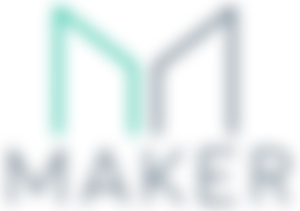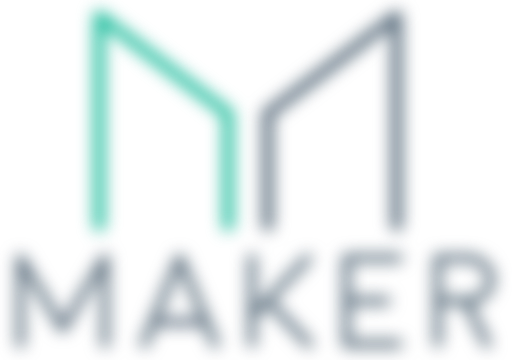Token Review: Maker
1st part: Maker
MakerDAO could be the best tokens fusion on the crypto world?
Well, let’s start!
We have to take a step back 6 years, when in 2014, two guys named Rune Christensen and Andy Milenius created Maker. They understood that the crypto Community needed a stable cryptocurrency without losing the decentralization of the system.
Maker (MKR) was then launched in 2018, after almost 4 years of work and development.
The project did not collect funds with an ICO. The tokens were distributed with a private sale to all those who understood and believed in the project. Maker's total supply is 1 million MKR and currently all tokens are in circulation.
Having births as a stable-coin MakerDAO is another decentralized organization dedicated to bring stability to the cryptocurrency economy.
The Maker Protocol employs a two-tokens system:
The first token is DAI, a collateral-backed stable coin that offers stability.

Dai is a hybrid stablecoin that relies on a complex mix of underlying assents, automated mechanism and external actors to achieve price stability.
Each Dai is backed by Ether held in MakerDAO smart contracts. These contracts are called Collateral Debt Positions (CDP). Anyone can lock up Ether in CDPs and new Dai will be released to the user in exchange for locking up the necessary collateral.
The second is MKR, a governance token that is used by stakeholders to maintain the system and manage DAI.

Source: https://prycto.com/partners/
Holders can vote on proposals submitted by any Ethereum account interested in submitting a proposal to the MakerDAO system. Proposals are smart contracts submitted to the Maker platform which aims to modify the internal governance and operational variables of the Maker Platform.
We can use MKR also to pay interest payments that users have created on the Collateralized Debt Position. These payments are known on Maker as “stability fees” .
The Maker Protocol can be used by anyone, anywhere, without any restrictions or personal-information requirements. How can you dislike the democracy of the crypto-environment?
All this may be nice and cool but what are the Dai use-case and benefits?
- Dai offers financial independence to all
It allows anyone to achieve financial independence, regardless of their location or circumstances.
- Self-sovereing money generation
The “Oasis Borrow” app allows users to access the Maker Protocol and generate Dai by locking their collateral in Maker Vault. Vaults offer individuals and businesses opportunities to create liquidity on their assets simply, quickly and at a relatively low cost.
Savings earned automatically
Dai holders can take advantage of the Dai saving rate, which, as detailed earlier, builds on the value of Dai by allowing users to earn on the Dai they hold and protect their savings from inflation.
Fast, low-cost remittances
Cross-border remittances can mean high service transfer fees, long delivery timelines, and frustrating exchange issues due to inflation. The Dai stable coin is used around the world as a medium of exchange because people have confidence in its value and efficiency.
Stability in volatile markets
It can help protect traders from volatility. Have you ever thought about a stable counterpart when trading altcoins, without relying too much on the USDT centralization and not yet demonstrated backing?
Could MakerDAO's system be successful in the long run?
With this first article on MakerDAO I am inaugurating this new section, that will be 100% about innovative projects. I am starting among the ones present in the Header of the homepage of Publish0x but once finished, I will move forward.
2nd part: MakerDAO, a locomotive for the Decentralized Finance (DeFi)
In this second part dedicated to MakerDAO I want to focus on five issues:
Maker Protocol and what can be expected from its future
Governance of the Maker Protocol
DAI stablecoin
Maker Vaults (smart contracts)
Price stability mechanisms
1: What is the Maker Protocol and what we can expect form its future?
We know that the Maker Protocol is among the main dApps of the Ethereum blockchain and it is the first decentralized finance (DeFi) application to register a major adoption.

It is run by people around the world who own the governance token of the MakerDAO ecosystem, MKR. Through a system of scientific governance that includes executive voting mechanisms and polls, MKR holders manage the Maker Protocol and the financial risks of the Dai, in order to ensure its stability, transparency and efficiency.
Achieving complete decentralization and increasing adoption are key points for the future of the Maker protocol.
When we face a stable price cryptocurrency, the available market is large because it can act as an exchange vehicle for many decentralized applications. The potential market for a stablecoin like Dai goes far beyond that of the blockchain. In fact, we could exploit its use in many other sectors.
We could see it in use in the trade and daily payments sector because the attenuation of the volatility of foreign exchange and the absence of intermediaries lead to a significant reduction in transaction costs.
It would not surprise me to see it applied in the gaming industry, where game developers could integrate an entire economy into them.
Dai may also be applied to a sector that I personally care a lot: charity. Institutions could keep their accounts in a transparent and distributed way, avoiding paper accounting records which would make it easier to tamper with data.
DAI future, from these perspectives, may be really florid and various.
2: What about the Governance of the Maker Protocol?
The governance token of the Maker Protocol, allows those who hold it to vote on changes to the Maker Protocol. Note that anyone, not only MKR holders, can submit proposals for an MKR vote.
Any voter-approved modifications to the governance variables of the Protocol will likely not take effect immediately in the future; rather, they could be delayed by as much as 24 hours if voters choose to activate the Governance Security Module. The delay would give MKR holders the opportunity to protect the system, if necessary, against a malicious governance by triggering a Shutdown.
The Maker Governance process includes proposal polling and executive voting.
Proposal polling is conducted to establish a rough consensus of community sentiment before any Executive Votes are cast.
Executive voting is held to approve (or not) changes to the state of the system.
At a technical level, smart contracts manage each type of vote. A Proposal Contract is a smart contract with one or more valid governance actions programmed into it. This smart contract can only be executed one time.
3: What is Dai specifically?

Dai is a decentralized, fair and collaterally supported stablecoin pegged to the US dollar. Dai is deposited in cryptocurrency wallets or within platforms and is supported on Ethereum and other popular blockchains.
Users can easily generate, acquire and use Dai. It is generated by depositing collateral assets in Maker Vault within the Maker protocol. In doing so, Dai enters circulation and allows users to obtain access to liquidity.
We can also get it by receiving it as a payment method, buying it from brokers or through exchanges.
This stablecoin can be used like any other cryptocurrency. We can use it for paying goods or services, we can send it to other people or keep it as savings through a feature of the Maker protocol called: Dai Savings Rate (DSR). The latter feature allows Dai holders to accrue savings automatically by locking the Dai into a DSR contract.
So, what does Dai have in common with the traditional money we use every day?
Dai was designed to perform the four main functions of money:
1) Exchange vehicle
2) Reserve of value
3) Accounting unit
4) Standard for deferred payments
4: Maker Vaults, the smart contracts of MakerDAO
All accepted collateral assets can be leveraged to generate Dai in the Maker Protocol through smart contracts called Maker Vaults. Users can access the Maker Protocol and create vaults through a number of different user interfaces.
Creating a vault is not complicated but generating Dai does create an obligation to repay the Dai, along with a stability fee, in order to withdraw the collateral leveraged and locked inside a vault.
This kind of smart contracts are inherently non-custodial, this means that users interact with vaults and the Maker Protocol directly, and each user has complete and independent control over their deposited collateral as long the value of that collateral doesn’t fall below the required minimum level.
5: How can the price of DAI stay stable to 1 USD?

Image source: https://mattwyles.files.wordpress.com/2014/02/e6bba185086379c636942bf776a7e749.jpg
Like stablecoin, Dai has a target price used to determine the value of collateral assets Dai holders receive in the case of an emergency shutdown. The target price for Dai is 1 USD.
Yes, you are not crazy, you have just read about an “emergency shutdown”!
So, what is it?
The “emergency shutdown” have two main purposes:
First, it is used during emergencies as a last-resort mechanism to protect the Maker Protocol against attacks on its infrastructure and directly enforce the Dai target price. Emergencies could include malicious governance actions, hacking, security breaches, and long-term market irrationality.
Second, Shutdown is used to facilitate a Maker Protocol system upgrade. The Shutdown process can only be controlled by Maker Governance.
MKR voters are also able to instantly trigger an emergency shutdown by depositing MKR into the emergency shutdown module, if enough MKR voters believe it is necessary. This prevents the Governance Security Module from delaying shutdown proposals before they are executed.
The emergency shutdown is composed by three phases:
The Maker Protocol shuts down and Vault owners withdraw assets: this prevents further vault creation and manipulation of existing vaults and freezes the price feeds.
Post-emergency shutdown auction processing: collateral auctions begin and must be completed within a specific amount of time.
Dai holders claim their remaining collateral: at the end of the auction, Dai holders use their Dai to claim collateral directly at a fixed rate that corresponds to the calculated value of their assets based on the Dai target price.
Whit this second article on Maker we have discovered a lot of peculiarities of this big project!
MakerDAO has become the driving force of decentralized finance with one of the most established developer communities in the cryptocurrency world. Maker is demonstrating the power of the blockchain and further features of a decentralized Governance!
Do you like the Maker Protocol? Do you also have Dai in your wallet?
Keep following me to find out the next coin I'm going to analyze.
Do you have other coins that you would like to see analyzed? Leave a comment here and your desire may find fulfillment!




